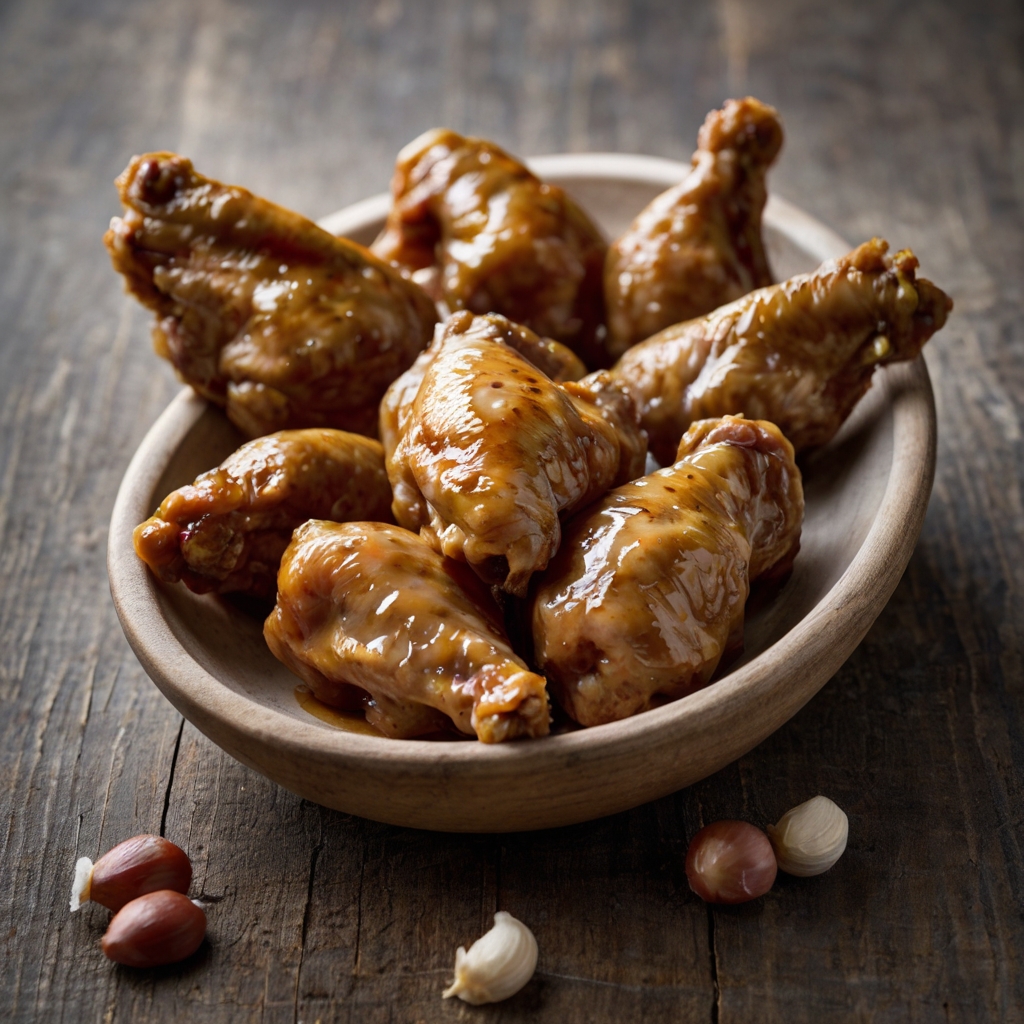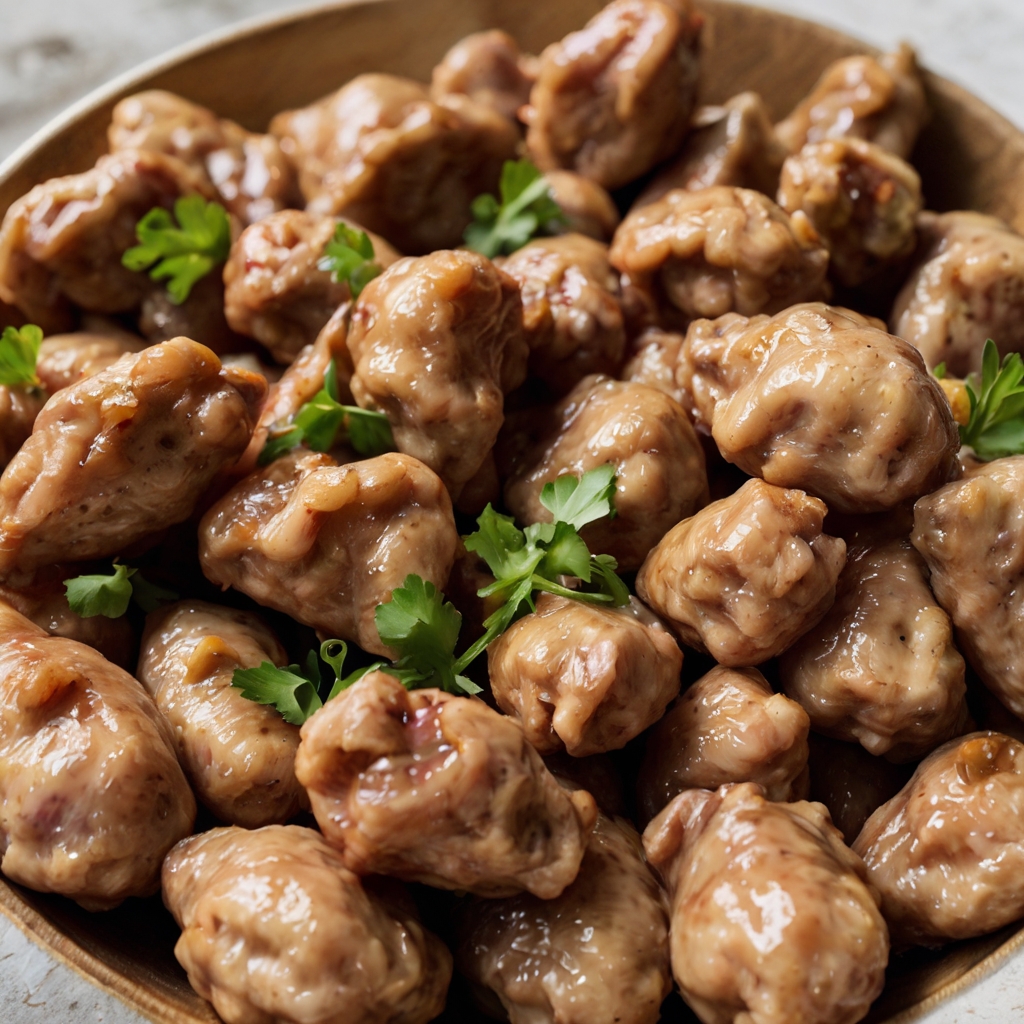Are chicken gizzards good for you? The answer might catch you by surprise. These humble organs are one of the most underappreciated parts of chicken, but they’re packed with nutrients. A single cup gives you 88% of your daily protein needs. They contain 44.1 grams of protein per cup with just 3.9 grams of fat and 223 calories.
Chicken gizzards do much more than just provide protein. A single serving gives you 63% of your daily vitamin B12 and 58% of your zinc needs. They’re also rich in iron (26% DV) and phosphorus (22% DV), which your body needs to function properly. The collagen in gizzards helps keep your skin healthy. Budget-conscious families will love that these nutritional powerhouses are affordable too. This forgotten superfood is a chance to add high-quality nutrition to your meals.

Table of Contents
- 1 What Are Chicken Gizzards?
- 2 Chicken Gizzard Nutrition Facts
- 3
- 4 Top 8 Chicken Gizzard Benefits
- 4.1 1. High protein supports muscle growth
- 4.2 2. Iron and B12 help fight fatigue
- 4.3 3. Zinc boosts immune function
- 4.4 4. Niacin supports heart and cholesterol health
- 4.5 5. Riboflavin aids energy production
- 4.6 6. Phosphorus strengthens bones
- 4.7 7. Collagen improves skin and joints
- 4.8 8. Versatile and budget-friendly protein source
- 5 Are There Any Downsides to Eating Gizzards?
- 6 How to Cook Chicken Gizzards the Healthy Way
- 7 Summing it all up
- 8 Here are some FAQs about if are chicken gizzards good for you:
- 8.1 Are chicken gizzards healthy?
- 8.2 Can you eat too many chicken gizzards?
- 8.3 Which is better for you, chicken livers or chicken gizzards?
- 8.4 Are chicken gizzards good for your kidneys?
- 8.5 Do gizzards have a lot of cholesterol?
- 8.6 What is the best way to cook chicken gizzards?
- 8.7 Does gizzard have collagen?
- 8.8 What happens if you eat undercooked chicken gizzards?
- 8.9 Do you have to rinse chicken gizzards before cooking?
What Are Chicken Gizzards?
The chicken gizzard might seem humble, but this extraordinary organ plays a vital role in a chicken’s digestive system. Essentially, the gizzard works as a specialized stomach in chickens and other birds that makes up for their lack of teeth. Nature’s food processor grinds up food before it enters the digestive tract.
Where they are found in the bird
The gizzard (also called the ventriculus) sits between the crop and small intestine in a chicken’s digestive system. Food moves down the esophagus and stays temporarily in the crop—a storage area at the esophagus’s base that can hold food for up to 12 hours. The food then travels to the proventriculus (the glandular or “true” stomach) before reaching the gizzard.
You’ll find the gizzard connected to the lower part of the true stomach and the small intestine’s beginning. This perfect placement lets it process food just before the intestines absorb nutrients. The gizzard belongs to a group of organs called “giblets” that you might discover in that mysterious paper packet inside a whole chicken, along with the liver, heart, and neck.
How they function in digestion
Birds have developed a clever solution to break down food since they don’t have teeth. The gizzard’s incredibly strong muscles contract with amazing force to grind food particles. Remarkably, the mechanical pressure during grinding can reach more than 585 kg/cm²—proof of this small organ’s surprising strength.
Chickens pick up tiny bits of grit, gravel, and pebbles as they peck at the ground for food. These particles get stuck in the gizzard and work with muscular contractions to break down food. The proventriculus creates an acidic environment that softens these stones, which stay in the gizzard until they become small enough to pass through.
A thick, multi-layered membrane made of koilin (a carbohydrate-protein complex) protects the gizzard’s powerful muscles during grinding. The bird’s diet determines this lining’s thickness—birds eating harder foods like grains and seeds develop thicker linings.
Why they are often overlooked
Gizzards pack impressive nutrition and offer a rich, distinctive flavor, yet American cuisine hasn’t embraced them fully. Notably, many cultures treasure gizzards as delicacies, including Haiti, Mexico, Southeast Asia, Europe, and Africa, where street vendors sell them as snacks, salad toppings, or side dishes.
American kitchens often skip gizzards for a couple of reasons. Most people don’t know much about organ meats or their preparation. The gizzard’s chewy texture needs specific cooking methods to become tender—usually slow cooking works best, just like with brisket or pork ribs.
Southern United States keeps the gizzard tradition alive, serving them fried with hot sauce or honey mustard, or adding them to classic dishes like New Orleans gumbo. French cuisine celebrates duck gizzards too, especially in the Dordogne region’s traditional Périgordian salad.
People often ask are chicken gizzards good for you, and the answer is a soaring win. The gizzard stands out as one of the chicken’s most nutritious parts, loaded with protein and low in fat. Health-conscious eaters looking to broaden their protein options will find gizzards an excellent nutritionally dense choice.
Chicken Gizzard Nutrition Facts
Exploring deeply into chicken gizzards’ nutritional profile shows why this overlooked organ meat belongs in health-conscious kitchens. The sort of thing I love about gizzards is how they pack substantial nutritional benefits into a budget-friendly package. My experience as a chef has taught me to value both flavor and nutrition.
Macronutrient breakdown: protein, fat, carbs
Chicken gizzards really shine because of their impressive protein content. A one-cup (145 gram) serving of simmered chicken gizzards gives you 44.1 grams of protein, which covers about 88% of your daily recommended value. This makes gizzards perfect if you want to boost your protein intake without extra calories.
Fat content in chicken gizzards stays surprisingly low, given their rich flavor. A one-cup serving has just 3.9 grams of total fat, only about 5% of your daily value. Only 1 gram comes from saturated fat, so gizzards are a heart-friendly protein choice.
Carbohydrate content is simple to explain—they have zero carbs. You’ll get 0 grams of sugar and 0 grams of dietary fiber. This makes them perfect for low-carb or ketogenic diets.
The calories stay moderate at 223 per cup of simmered gizzards. That’s enough to satisfy hunger without blowing your daily calorie budget.
Key vitamins: B12, niacin, riboflavin
Chicken gizzards are packed with B-complex vitamins, especially B12. Each cup gives you 1.51 mcg of vitamin B12, covering 63% of your daily value. Your brain needs this vitamin, and it helps make red blood cells too.
Niacin (vitamin B3) shows up in good amounts, with one cup giving you 4.52 mg, about 28% of your daily value. Adding gizzards to your meals helps with nutrient processing and better cholesterol levels.
Riboflavin (vitamin B2) is another standout vitamin in chicken gizzards. One cup has 0.3 mg, meeting about 23% of your daily needs. Like niacin, riboflavin helps turn your food into energy.
You’ll also find pantothenic acid (vitamin B5) in chicken gizzards, getting about 13% of your daily needs per 100 grams. This adds to their impressive vitamin lineup.
Important minerals: iron, zinc, phosphorus
The mineral content in chicken gizzards is remarkable. A one-cup serving delivers 4.63 mg of iron, about 26% of your daily value. Adding gizzards to your diet can help maintain healthy red blood cells.
Zinc shows up in abundance with 6.41 mg per cup, meeting 58% of your daily needs. Your immune system needs this mineral to fight infections and help with wound healing and skin health.
Phosphorus comes in at 274.05 mg per cup, covering about 22% of your daily needs. Your bones need this mineral, and it helps your cells work properly.
These gizzards also pack selenium (46% DV per 100g), potassium (6% DV per serving), plus some magnesium and calcium.
People often ask “are chicken gizzards good for you?” The numbers tell the story clearly. Their protein-to-energy ratio of 8.0, low energy density of 0.9, and wealth of essential nutrients make chicken gizzards a nutritional powerhouse that deserves more attention in health-focused kitchens.
Top 8 Chicken Gizzard Benefits
Chicken gizzards pack impressive nutritional benefits that might surprise even the most health-conscious foodies. Are chicken gizzards good for you? Absolutely—let me share why these underappreciated morsels deserve a spot in your kitchen.
1. High protein supports muscle growth
A cup of simmered chicken gizzards delivers a whopping 44.1 grams of protein, meeting about 88% of your daily needs. You’ll find all essential amino acids in this high-quality protein, making gizzards ideal for muscle development and repair. My experience as a chef shows how this protein-rich ingredient keeps you satisfied longer, which helps with active lifestyles and weight management goals.
2. Iron and B12 help fight fatigue
Chicken gizzards could be your answer to fatigue. Their rich iron content (26% DV) helps create red blood cells and moves oxygen through your body. These nutritional powerhouses provide 63% of your daily vitamin B12 needs, which helps turn food into energy and supports brain function. Gizzards are a natural way to curb fatigue and boost your energy levels.
3. Zinc boosts immune function
Gizzards provide 58% of your daily zinc requirements, making them perfect for immune system support. Zinc plays a vital role to fight infections, heal wounds, maintain skin health, and help with DNA/RNA synthesis. Your body becomes better equipped to handle seasonal illnesses with gizzards in your diet.
4. Niacin supports heart and cholesterol health
These nutritious morsels contain most important amounts of niacin (vitamin B3), providing about 28% of your daily needs. This nutrient helps metabolize macronutrients and improves cholesterol health. Your heart function and cardiovascular wellness can benefit from regular gizzard consumption.
5. Riboflavin aids energy production
Gizzards meet 23% of your daily riboflavin (vitamin B2) requirements and help convert macronutrients into usable energy. This B vitamin’s antioxidant properties reduce oxidative stress and fight free radicals. Sautéing gizzards preserves more riboflavin than boiling, since cooking water can lose twice as much of this vitamin.
6. Phosphorus strengthens bones
Your daily phosphorus needs are met by 22% when you eat gizzards. This mineral works with calcium to build stronger bones and is vital for bone mineralization. Your kidney function and body’s pH balance also benefit from this essential mineral.
7. Collagen improves skin and joints
Gizzards’ collagen content helps maintain joint health, skin elasticity, and overall connective tissue strength. Beauty and wellness circles value this protein to keep skin youthful and firm. Your joints can become more comfortable and mobile thanks to the collagen in gizzards.
8. Versatile and budget-friendly protein source
Chicken gizzards are remarkably affordable at around $1.50 per pound. These versatile cuts shine in soups, stews, stir-fries, or simply grilled with herbs. Families looking to eat healthy without breaking the bank will find gizzards to be an excellent protein option.
Are There Any Downsides to Eating Gizzards?
Chicken gizzards pack impressive nutritional benefits, but they’re not perfect. Let’s get into some drawbacks to help you decide if they’re right for you.
High cholesterol content
Chicken gizzards have niacin, but they pack more cholesterol than other chicken parts. You need to watch your portions if you have high cholesterol or heart disease risks. A 100-gram serving has about 370 milligrams of cholesterol. This is a big deal as it means that the recommended daily limit of 300 milligrams. The good news? These gizzards stay nowhere near high in saturated fats – the real troublemaker behind high cholesterol.
Moderate purine levels and gout risk
The purine levels in chicken gizzards sit in the middle range. These substances turn into uric acid in your body. You should be careful if you have gout or kidney issues. Too many purines might lead to gout flare-ups or kidney stones. The numbers show gizzards fall into the “moderate-purine” group at 142.9-169.8 mg per 100g. People with gout might want to enjoy these treats once in a while rather than keep taking them.
Sodium and unhealthy fats in fried versions
Many people love their gizzards fried, but this cooking method changes everything about their nutrition. Deep-fried versions come loaded with unhealthy oils that pile on calories and bad fats. The rubs, seasonings, and sauces that go with fried gizzards pump up the sodium levels. Try air-frying, sautéing, or simmering instead. These methods keep the nutrients intact and taste great too.
Concerns with low-quality sourcing
The chicken’s quality makes all the difference with organ meats. Cheaper chickens often come from farms that use antibiotics to accelerate growth and fight disease in packed spaces. This practice helps create antibiotic-resistant bacteria, making it harder to treat infections in chickens and humans alike. Your best bet is to grab gizzards from trusted sources that focus on quality and environmentally responsible farming.
How to Cook Chicken Gizzards the Healthy Way
The perfect chicken gizzards depend on how you cook them. I’m a chef who loves both healthy food and great taste, and I can tell you that well-prepared gizzards aren’t just good for you—they taste amazing. Let me show you how to turn these simple organs into something delicious while keeping all their health benefits.
Boiling and simmering for tenderness
Tender gizzards start with proper boiling. You’ll want to cover cleaned gizzards with water, adding an extra inch on top. The flavor really comes alive when you add aromatics like onions, celery, and bay leaves. Bring everything to a boil, then let it simmer for 20-45 minutes until tender. You can cook them longer (60-90 minutes) to get very soft gizzards, or keep it shorter if you like more texture. Many chefs find that pressure cooking for 30-40 minutes works best.
Pan-frying with minimal oil
A quick pan-fry after boiling gives you tasty gizzards without too much fat. Just heat a little oil in a skillet over medium-high heat. Your pre-boiled gizzards need about 15 minutes to cook. Add salt and pepper to taste. This method keeps all the good nutrients while making them taste great—perfect if you’re wondering whether fried chicken gizzards can still be healthy.
Stewing and braising for flavor
Stewing makes gizzards taste incredible. The process is simple: boil them first, then simmer with vegetables and herbs in a bit of liquid until they develop rich flavors. Braising works differently—you sear the gizzards before cooking them slowly in a covered pot with just a little liquid. This breaks down tough fibers and concentrates the flavors. Let them simmer until half the liquid disappears (about 7 minutes) for perfect tenderness.
Tips for cleaning and prepping gizzards
Clean gizzards need proper preparation:
- Slice each gizzard lengthwise
- Remove any yellow inner lining and silverskin
- Rinse really well under cold water
- Cut off any green or fatty parts
- Dry with paper towels
The silverskin doesn’t need removal for slow cooking but should come off for quick-cooking methods. A salt water soak before cooking helps draw out impurities and makes the gizzards more tender.
Summing it all up
Chicken gizzards are one of the most underappreciated nutritional powerhouses in today’s kitchens. This humble organ deserves to be called a forgotten superfood, and here’s why.
The numbers tell an impressive story – each cup packs 44.1 grams of protein with minimal fat and zero carbs. That makes gizzards perfect for clean eating enthusiasts. Their vitamin and mineral content outshines many regular protein sources. You’ll get your daily dose of B12, zinc, iron, and phosphorus.
Of course, people worry about cholesterol levels and cooking techniques. But these concerns don’t match the amazing health perks gizzards offer. Few foods can deliver this mix of muscle-building protein, fatigue-fighting iron, immunity-boosting zinc, and skin-enhancing collagen.
You might question their taste and texture. Well-cooked gizzards pack amazing flavor at a fraction of other protein costs. They work great in hearty stews and flavorful stir-fries.
Families watching their budget should take another look at this overlooked cut. At just $1.50 per pound, gizzards pack nutrition that matches pricier protein options.
Are chicken gizzards good for you? That’s a soaring win. While Western kitchens often skip them, cultures worldwide have treasured gizzards for generations, and with good reason too. They’re affordable, versatile, and packed with nutrients – making them worth another look.
Next time you visit your local butcher or grocery store, grab some chicken gizzards. Your body and wallet will thank you for choosing this nutritional gem that’s been right under your nose all along.


